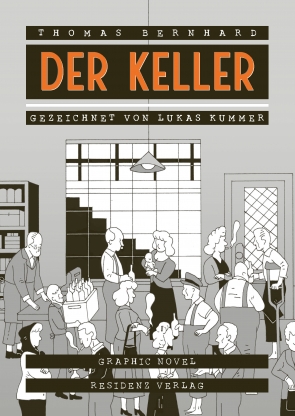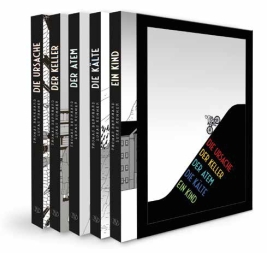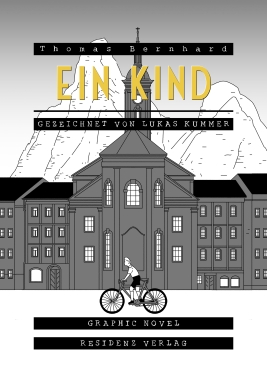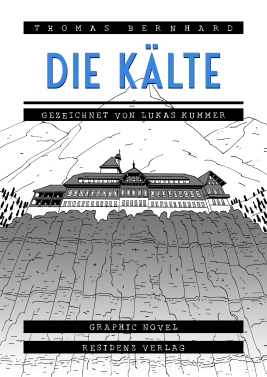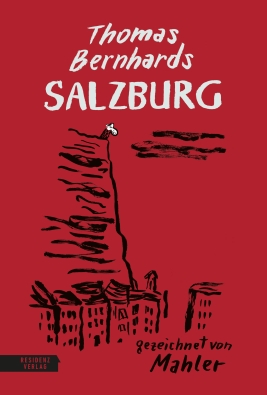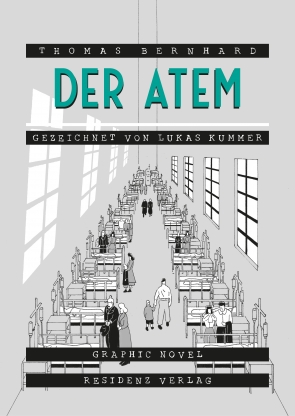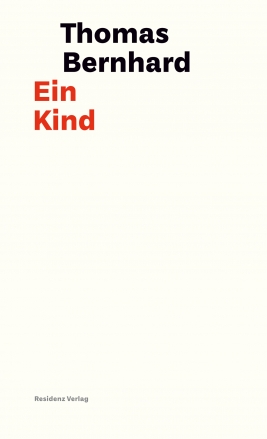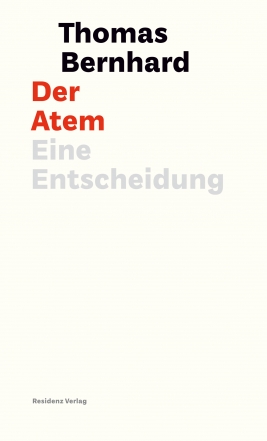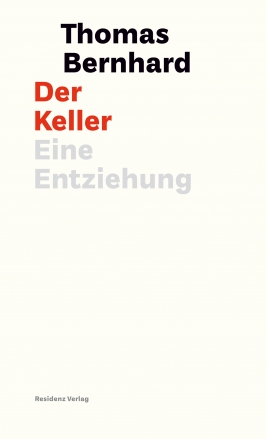Die Zeichnungen arbeiten wie Bernhards Sprache mit Wiederholungen. Sie setzen den typisch Bernhard’schen Rhythmus überzeugend ins Bild.
[Quelle: DER STANDARD]
(…) wieder hat man das Gefühl, Bernhard und Kummer haben zusammengearbeitet.
[Quelle: Peter Pisa, KURIER]
Die im dritten Lehrjahr zugezogene schwere Lungenerkrankung wird in einem einzigen vogelperspektivischen Blick in einen Krankensaal angedeutet. Er gibt wohl auch einen Vorgeschmack auf die Graphic Novel Version des dritten Bands, "Der Atem. Eine Entscheidung". So seltsam es klingen mag: Man darf sich darauf freuen!
[Quelle: Wolfgang Huber-Lang, APA]
Man kann dem Residenz-Verlag in der Bernhardstadt Salzburg nur fortwährend zur Idee gratulieren, den genialen Zeichner Thomas Kummer für die Gestaltung der Thomas Bernhard – Graphic Novels gefunden zu haben. Er schafft es mit leichtem Strich, die Schwere der bernhardschen Gedankenwelt zu binden, das ist starke Kunst ohne Mätzchen, immer nah am Oeuvre des großen Österreichers (…) Lukas Kummer gelingt es wunderbar, die Spezifik der Sprache Thomas Bernhards in seine eigene Bildwelt zu exportieren. Durch minimale Veränderungen seines Strichs in sich wiederholenden Bildmotiven, die parallel zu Bernhards sich minimal veränderndem Textmantra verlaufen, schafft er ein Gesamtwerk, das Bild und Text dynamisch vereint. Fette Bildwelt, knorke Kunst, geiles Teil!
[Quelle: Frank Willmann, NEUES DEUTSCHLAND]
(…) wieder ist Kummer ein großer Wurf gelungen, der der Vorlage absolut gerecht wird. Er hat konsequent die Textfläche auf das Wesentliche und zentrale Motive hin verdichtet und streng formalisierte Panelflächen gestaltet, mit denen er den Rhythmus des Bernhardschen Erzählduktus grafisch umsetzt. (…) Kummers Version ist eine eigenständige Interpretation. Als solche macht sie neugierig, Bernhards Autobiografie in Gänze zu entdecken. Dass Kummer das gelingt, ist nicht wenig.
[Quelle: Andreas Gebhardt, HESSISCHE ALLGEMEINE]
Mit Lukas Kummers Illustration dieser Geschichte werden die Bilder, sowohl zu diesem Zeitfenster der Nachkriegszeit als auch zu den von Bernhard empfundenen Zwängen, eindrucksvoll und sehr individuell unterstrichen.
[Quelle: VOICES OF THE STREET]
Graphic Novel mit Sogwirkung.
[Quelle: Holger Moos, GOETHE.DE]
Graphic Novels zählen längst zur etablierten Literatur. Jetzt hat Lukas Kummer sich dem Lebensbericht von Thomas Bernhard angenommen. Kein leichtes Unterfangen bei diesem Autor – doch ein geglücktes.
[Quelle: RHEINISCHE POST]
Lukas Kummer hat aus der planvoll von enervierenden Endlossätzen und wahnwitzigen Wiederholungen geprägten Prosa eine großartige Graphic Novel gemacht.
[Quelle: Hendrik Werner, WESER KURIER]
„Der Keller“ ist eine faszinierende, wenn auch düstere Komposition aus den autobiographischen texten Thomas Bernhards des Jahres 1976 und der eigenwilligen Illustration Lukas Kummers. Dieses gewagte Unternehmen erfährt hier tatsächlich eine kunstvolle, ausdrucksstarke Symbiose.
[Quelle: VOICES OF THE STREET]
Das Auflehnen des Ichs gegen die feindliche Umwelt und Bernhards eigenständige Sprache sind unter Kummers Feder alles andere als Begleitmaterial. Seine erschreckend symmetrischen Bilder sind Bernhards Texten ebenbürtig.
[Quelle: Giovanni Peduto, GIUBANSKI]
Als Nicolas Mahler den Roman "Alte Meister" und das Stück "Der Weltverbesserer" in seine typische, ebenso minimalistische wie ironisch-lakonische Bildersprache übersetzte, glaubte man, der große Misanthrop der österreichischen Literatur hätte in ihm den idealen Vermittler für eine junge, neue Leserschichte gefunden. Nun stellt sich heraus: Kummers Strich entspricht der Hermetik des in sich kreisenden, mit Wiederholungen und Insistierungen arbeitenden, sich in einen Furor steigernden, aber dennoch Distanz wahrenden Stils Thomas Bernhards noch besser.
[Quelle: Wolfgang Huber-Lang, APA]
Lukas Kummer ist mit seiner Graphic Novel „Der Keller“ ein außergewöhnliches und autobiographisches Stück Comic-Kunst gelungen.
[Quelle: Sven Biller, I-LOVE-URBANART]
Die Zeichnungen liefern eine ganz neue Sichtweise auf das Geschehen, sie visualisieren nicht nur, was geschieht, sie erschaffen auch eine eigene Welt in besonderen Farben. Wo man bisher bei Lesungen zuhören konnte, kann man jetzt auch zusehen, wie die Geschichte für die Figuren ihren Lauf nimmt.
[Quelle: Elke Schneefuss, LANDESZEITUNG]
Den so typischen Bernhard-Ton, dieses unbarmherzige Ausweglosigkeitsratern, treffen die beiden bislang vorliegenden Bände (…).
[Quelle: Joachim Leitner, TIROLER TAGESZEITUNG]
(…) magnificent. (…) Lukas Kummer has managed to convey the dark and pessimistic atmosphere of Bernhard’s autobiographical publications.
[Quelle: Thomas Hochwarter, AUSTRIAN CULTURE CHANNEL]
Kummer hat einen sehr klaren, kühlen Zeichenstil, die häufige Wiederholung nur leicht modifizierter Panels entspricht exakt dem sprachlichen System Bernhardts.
[Quelle: Christian Meyer-Pröpstl, CHOICES]
Wie im ersten Band bestechen auch im zweiten die formale Fertigkeit und der Aufbau. Mit der kristallin scharfen, kalten, präzisen Komposition in extremer, Zwischentöne vermeidender Technik (…) entspricht der Zeichner einfühlsam den monodisch-syntaktischen Hämmern der Textvorlage.
[Quelle: Reinhold Tauber, OÖ NACHRICHTEN]
Lukas Kummer hat für Bernhards Text eine ganz einmalige, durch minimalistische und sequenzielle Zeichnungen geprägte Bildsprache gefunden. Wie bereits beim Vorgängerwerk ist bemerkenswert, wie gekonnt die Bildsprache der Sprache des Originalwerks entspricht, die von Wiederholungen geprägt ist. Der Comic ist für geduldige Erwachsene geeignet, die Freude an anspruchsvoller grafischer Inszenierung haben.
[Quelle: Maria-Inti Metzendorf, EKZ]
(…) die Bilder von Lukas Kummer greifen die vielen Wiederholungen [im Text Bernhards] auf. (…) Alles ist sehr einfach dargestellt, schwarz-weiß ohne Schnörkel und das passt (…) gut zum Bernhard`schen Sprachkosmos.
[Quelle: LITERATURLEUCHTET]
Ebenso gelungen wie der erste Band.
[Quelle: PAGE ONLINE]
Dieser Mann hat Bernhard verstanden. Definitiv eine Graphic Novel mit Sogwirkung.
[Quelle: Matthias Eichardt, JENAER STADTMAGZIN]
Man liest und schaut und entdeckt in der Komprimierung der Graphic Novel Thomas Bernhard noch einmal für sich.
[Quelle: Christina Repolust, APROPOS]
(…) hervorragende Bilder (…). Ein schwarz-weißer Graphic Novel-Band, dessen Bildabfolge mit der Sogwirkung des Textes von Bernhard zeichnerisch sehr gut übereinstimmt.
[Quelle: Hermann Koch, P.S.]
Eine hervorragende, beengende, beängstigende Adaption von Thomas Bernhards Tagebüchern. Kummers erschreckend symmetrische Bilder sind Bernhards Text ebenbürtig.
[Quelle: Giovanni Peduto, TAGESSPIEGEL]
Entdeckungsreise zu dem österreichischen Großgrantler.
[Quelle: Christian Schlüter, BERLINER ZEITUNG]
Streng komponierte, Schwarz-Weiß-Grau-Bilder, die in ihrer Rhythmik und ihren Wiederholungen die Sprache Bernhards aufgreifen (…). Eine schöne Sache.
[Quelle: Oliver Herzig, XING.COM]
In „Der Keller“ entzieht sich der gequälte Schüler dem Gymnasium, dem Internat und dem Salzburger Bürgertum. Im Keller des Lebensmittelgeschäfts von Karl Podlaha lernt Bernhard, als soziales Wesen zu existieren und sich nicht zerstören zu lassen.
[Quelle: BÜCHER MAGAZIN]
… zu Recht wird zweite Band des Zeichners Lukas Kummer hochgelobt.
[Quelle: NOVUM]
Größtes Lesevergnügen!
[Quelle: Gert Damberg, WEEKEND]
Lukas Kummer trifft erneut den Nerv des Textes mit seinen Zeichnungen. Da möchte man am liebsten auch gleich zum Einkaufen in den Keller des Podlaha laufen. Eine schöne Fortsetzung der Comicreihe zu Bernhards autobiografischem Werk!
[Quelle: Anka Willamowius, BUCH-LADY.DE]
